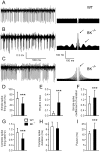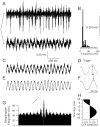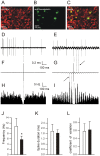BK channels control cerebellar Purkinje and Golgi cell rhythmicity in vivo
- PMID: 19956720
- PMCID: PMC2776494
- DOI: 10.1371/journal.pone.0007991
BK channels control cerebellar Purkinje and Golgi cell rhythmicity in vivo
Abstract
Calcium signaling plays a central role in normal CNS functioning and dysfunction. As cerebellar Purkinje cells express the major regulatory elements of calcium control and represent the sole integrative output of the cerebellar cortex, changes in neural activity- and calcium-mediated membrane properties of these cells are expected to provide important insights into both intrinsic and network physiology of the cerebellum. We studied the electrophysiological behavior of Purkinje cells in genetically engineered alert mice that do not express BK calcium-activated potassium channels and in wild-type mice with pharmacological BK inactivation. We confirmed BK expression in Purkinje cells and also demonstrated it in Golgi cells. We demonstrated that either genetic or pharmacological BK inactivation leads to ataxia and to the emergence of a beta oscillatory field potential in the cerebellar cortex. This oscillation is correlated with enhanced rhythmicity and synchronicity of both Purkinje and Golgi cells. We hypothesize that the temporal coding modification of the spike firing of both Purkinje and Golgi cells leads to the pharmacologically or genetically induced ataxia.
Conflict of interest statement
Figures







Similar articles
-
Disruption of the olivo-cerebellar circuit by Purkinje neuron-specific ablation of BK channels.Proc Natl Acad Sci U S A. 2010 Jul 6;107(27):12323-8. doi: 10.1073/pnas.1001745107. Epub 2010 Jun 21. Proc Natl Acad Sci U S A. 2010. PMID: 20566869 Free PMC article.
-
p75 regulates Purkinje cell firing by modulating SK channel activity through Rac1.J Biol Chem. 2014 Nov 7;289(45):31458-72. doi: 10.1074/jbc.M114.589937. Epub 2014 Sep 24. J Biol Chem. 2014. PMID: 25253694 Free PMC article.
-
Conditional protein phosphorylation regulates BK channel activity in rat cerebellar Purkinje neurons.J Physiol. 2003 Oct 15;552(Pt 2):379-91. doi: 10.1113/jphysiol.2003.046441. J Physiol. 2003. PMID: 14561822 Free PMC article.
-
Survival strategies for mouse cerebellar Purkinje neurons lacking PMCA2.Neurosci Lett. 2018 Jan 10;663:25-28. doi: 10.1016/j.neulet.2017.09.045. Neurosci Lett. 2018. PMID: 29452612 Review.
-
Fast oscillation in the cerebellar cortex of calcium binding protein-deficient mice: a new sensorimotor arrest rhythm.Prog Brain Res. 2005;148:165-80. doi: 10.1016/S0079-6123(04)48014-5. Prog Brain Res. 2005. PMID: 15661189 Review.
Cited by
-
Increased glutamate transporter-associated anion currents cause glial apoptosis in episodic ataxia 6.Brain Commun. 2020 Mar 4;2(1):fcaa022. doi: 10.1093/braincomms/fcaa022. eCollection 2020. Brain Commun. 2020. PMID: 32954283 Free PMC article.
-
Emergence of a 600-Hz buzz UP state Purkinje cell firing in alert mice.Neuroscience. 2014 Mar 28;263:15-26. doi: 10.1016/j.neuroscience.2014.01.007. Epub 2014 Jan 15. Neuroscience. 2014. PMID: 24440752 Free PMC article.
-
Purkinje cell BKchannel ablation induces abnormal rhythm in deep cerebellar nuclei and prevents LTD.Sci Rep. 2018 Mar 9;8(1):4220. doi: 10.1038/s41598-018-22654-6. Sci Rep. 2018. PMID: 29523816 Free PMC article.
-
Downregulation of the Glial GLT1 Glutamate Transporter and Purkinje Cell Dysfunction in a Mouse Model of Myotonic Dystrophy.Cell Rep. 2017 Jun 27;19(13):2718-2729. doi: 10.1016/j.celrep.2017.06.006. Cell Rep. 2017. PMID: 28658620 Free PMC article.
-
Cerebellar Cortex 4-12 Hz Oscillations and Unit Phase Relation in the Awake Rat.Front Syst Neurosci. 2020 Nov 10;14:475948. doi: 10.3389/fnsys.2020.475948. eCollection 2020. Front Syst Neurosci. 2020. PMID: 33240052 Free PMC article.
References
Publication types
MeSH terms
Substances
LinkOut - more resources
Full Text Sources
Molecular Biology Databases
Research Materials

